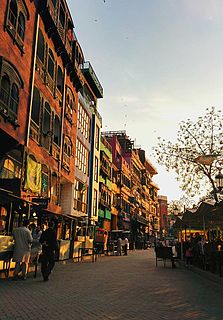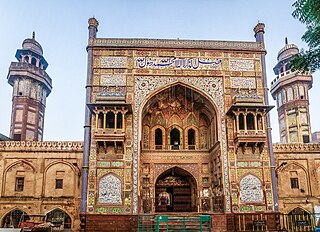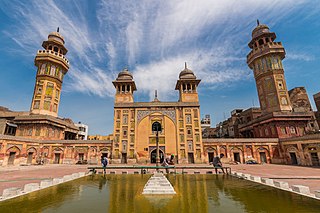 W
WThe Walled City of Lahore, also known as Old City, forms the historic core of Lahore, Pakistan. The city was established around 1000 CE in the western half of the Walled City, which was fortified by a mud wall during the medieval era.
 W
WThe Badshahi Mosque is a Mughal era mosque in Lahore, capital of the Pakistani province of Punjab, Pakistan. The mosque is located west of Lahore Fort along the outskirts of the Walled City of Lahore, and is widely considered to be one of Lahore's most iconic landmarks.
 W
WBegum Shahi Mosque, officially The Mosque of Mariyam Zamani Begum, is an early 17th-century mosque situated in the Walled City of Lahore, Punjab, Pakistan. The mosque was built between 1611 and 1614 during the reign of Mughal Emperor Jahangir in honour of his mother. It is Lahore's earliest surviving example of a Mughal-era mosque, and influenced construction of the larger Wazir Khan Mosque a few decades later. This mosque was turned in name of most celebrated Sikh hero Bhai Mani Singh ji, as Shaheed Ganj Bhai Mani Singh, under Sikh rule.
 W
WRajput Bhati Gate is one of the historic thirteen gates of the Walled City of Lahore in Lahore, Punjab, Pakistan. Bhati Gate also serves as a union council located in the Ravi Zone. The gate is located near Data Darbar and is similar in design to Kashmiri Gate.
 W
WData Darbar, located in the city of Lahore, Punjab, Pakistan is the largest Sufi shrine in South Asia. It was built to house the remains of Ali Hujwiri, commonly known as Data Ganj Baksh, a Sufi saint from Ghazni in present-day Afghanistan, who is believed to have lived on the site in the 11th century CE.
 W
WFakir Khana is a private museum and house located in Lahore, Pakistan, owned by the Fakir family. Fakhir Khana contains over 20,000 objects, and is the largest privately owned museum in South Asia.
 W
WFort Road Food Street is a food street located between Fort Road and Roshnai Gate of the Walled City in Lahore, Punjab, Pakistan. The street was reconstructed and opened in 2012 as a tourist attraction, by offering Lahori cuisine and views of Badshahi Mosque. The street was inaugurated on 21 January 2012, by Hamza Shahbaz Sharif to replace Gawalmandi Food Street.
 W
WFort Road, Lahore is a road in the Old Walled City of Lahore, Pakistan. It is one of Lahore's most famous and historically significant roads. It is so named because it flanks the Lahore Fort on its southern and eastern sides.
 W
WGreater Iqbal Park, formerly Minto Park, is an urban park located in the outskirts of the Walled City in Lahore, Pakistan. Before current renovations and expansion its name was Iqbal Park. Noted as the home of Minar-e-Pakistan, the 125-acre park includes an artificial lake which spreads over four acres which includes an 800-feet-long musical fountain. Other attractions includes a soft rail, library, an open-air gym and a food court. The tombs of Allama Iqbal and Hafeez Jalandhari are also located in the park.
 W
WThe Haveli of Nau Nihal Singh is a haveli mansion located in Lahore, Pakistan. Dating from the Sikh era of the mid-19th century, the haveli is considered to be one of the finest examples of Sikh architecture in Lahore, and is the only Sikh-era haveli that preserves its original ornamentation and architecture.
 W
WHazuri Bagh is a garden in Lahore, Punjab, Pakistan, bounded by the Lahore Fort to the east, Badshahi Mosque to the west, the Samadhi of Ranjit Singh to the north, and the Roshnai Gate to the south. The Serai Alamgiri caravanserai formerly stood where Hazuri Bagh is now located. In the centre of the park stands the Hazuri Bagh Baradari, built by Ranjit Singh in 1818 to celebrate his capture of the Koh-i-Noor diamond from Shuja Shah Durrani in 1813.
 W
WThe Hazuri Bagh Baradari is a baradari of white marble located in the Hazuri Bagh of Lahore, Pakistan. It was built by Maharaja Ranjit Singh, the Sikh ruler of Punjab to celebrate his capture of the Koh-i-Noor diamond from Shuja Shah Durrani in 1813. Its construction was completed in 1818.
 W
WMinar-e-Pakistan is a national monument located in Lahore, Pakistan. The tower was built between 1960 and 1968 on the site where the All-India Muslim League passed the Lahore Resolution on 23 March 1940 - the first official call for a separate and independent homeland for the Muslims of British India, as espoused by the two-nation theory. The resolution eventually helped lead to the emergence of an independent Pakistani state in 1947.
 W
WThe Tomb of Allama Muhammad Iqbal, or Mazaar-e-Iqbal is a mausoleum located within the Hazuri Bagh, in the Pakistani city of Lahore, capital of Punjab province.
 W
WThe Naulakha Pavilion is a white marble personal chamber with a curvilinear roof, located beside the Sheesh Mahal courtyard, in the northern section of the Lahore Fort in Lahore, Pakistan. The monument is one of the 21 monuments situated within the Lahore Fort, with its western façade providing a panoramic view of the ancient city of Lahore.
 W
WNeevin Mosque, or Neevin Masjid, is a 15th-century mosque built during the Lodi dynasty of the Delhi Sultanate. It is located in the ancient Walled City of Lahore, in Pakistan's Punjab province.
 W
WThe Oonchi Mosque, or Oonchi Masjid is a Mughal-era mosque located along the Hakiman Bazaar, near the Bhati Gate which leads into the Walled City of Lahore, in Pakistan. The mosque may date from the reign of the Emperor Akbar. It has been extensively renovated throughout its history, resulting in little of the original mosque's decorative elements being preserved.
 W
WThe Samadhi of Ranjit Singh is an 18th-century building in Lahore, Pakistan that houses the funerary urns of the Sikh ruler Ranjit Singh. It is located adjacent the Lahore Fort and Badshahi Mosque, as well the Gurdwara Dera Sahib which marks the spot where the 5th guru of Sikhism, Guru Arjan Dev, died.
 W
WThe Shab Bhar Mosque is a colonial era mosque in the Shah Alami neighbourhood of Lahore, Pakistan. The mosque is said to have been built overnight, following a dispute between local Hindus and Muslims in 1917.
 W
WThe Shahi Hammam, also known as the Wazir Khan Hammam, is a Persian-style bath which was built in Lahore, Pakistan, in 1635 C.E. during the reign of Emperor Shah Jahan. It was built by chief physician to the Mughal Court, Ilam-ud-din Ansari, who was widely known as Wazir Khan. The baths were built to serve as a waqf, or endowment, for the maintenance of the Wazir Khan Mosque.
 W
WThe Sunheri Mosque, also known as the Talai Mosque, is a late Mughal architecture-era mosque in the Walled City of Lahore, capital of the Pakistani province of Punjab.
 W
WThe Walled City of Lahore Authority is a semi-government organisation in Lahore, Pakistan, established and funded by the Government of Punjab for conservation, planning and development, regulation and management of the Walled City of Lahore.
 W
WThe Wazir Khan Chowk is a town square located in the Walled City of Lahore, Pakistan that is located at the main entrance of the Wazir Khan Mosque.
 W
WThe Wazir Khan Mosque is 17th century mosque located in the city of Lahore, capital of the Pakistani province of Punjab. The mosque was commissioned during the reign of the Mughal Emperor Shah Jahan as part of an ensemble of buildings that also included the nearby Shahi Hammam baths. Construction of Wazir Khan Mosque began in 1634 C.E., and was completed in 1641. It is on the UNESCO World Heritage Tentative List.
 W
WThe Well of Dina Nath was intended to be a water well in the Wazir Khan Chowk in Lahore, Pakistan. The well's construction by in the 19th century by a Sikh nobleman sparked controversy, given its location in the immediate vicinity of the Wazir Khan Mosque.